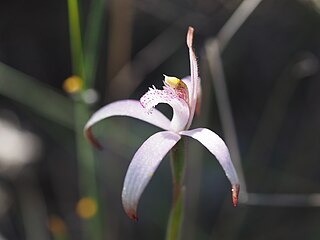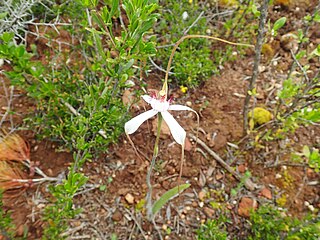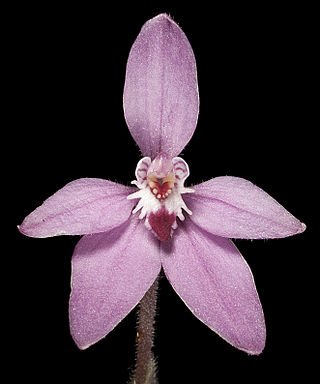Caladenia bicalliata subsp. bicalliata, commonly known as the limestone spider orchid or dwarf limestone spider orchid, is a plant in the orchid family Orchidaceae and is native to the south-west of Western Australia and coastal areas of South Australia. It has a single erect, hairy leaf and one or two cream-coloured flowers with reddish-brown tips.
Caladenia bicalliata subsp. cleistogama, commonly known as the shy limestone spider orchid or sandhill spider orchid, is a plant in the orchid family Orchidaceae and is native to the south-west of Western Australia. It has a single erect, hairy leaf and one or two cream-coloured flowers which are smaller than those in subspecies bacalliata.
Caladenia denticulata subsp. rubella, commonly known as the clumped spider orchid, is a plant in the orchid family Orchidaceae and is endemic to the south-west of Western Australia. It has a single erect, hairy leaf and one or two dull or pinkish red flowers with prominent dull red markings and with a white labellum with red markings.

Caladenia hirta subsp. hirta, commonly known as the sugar candy orchid or candy orchid, is a plant in the orchid family Orchidaceae and is endemic to the south-west of Western Australia. It has a single leaf and up to three creamy-white or pink flowers with brownish tips and a brown back.

Caladenia hirta subsp. rosea, commonly known as the pink candy orchid or candy orchid, is a plant in the orchid family Orchidaceae and is endemic to the south-west of Western Australia. It is a widespread and common orchid which has a single leaf, up to three pale pink to deep pink flowers and often grows in clumps.

Caladenia longicauda subsp. australora, commonly known as the southern white spider orchid, is a plant in the orchid family Orchidaceae and is endemic to the south-west of Western Australia. It has a single hairy leaf and up to three mostly white, relatively small flowers. It grows in woodland and mallee on the south coast in and near the Fitzgerald River National Park.

Caladenia longicauda subsp. clivicola, commonly known as the Darling Scarp white spider orchid, or hills white spider orchid is a plant in the orchid family Orchidaceae and is endemic to the south-west of Western Australia. It has a single hairy leaf and up to three mostly white flowers with long, drooping lateral sepals and petals, a relatively small, narrow labellum and narrow labellum teeth. It grows in a restricted area, mostly on the Darling Scarp.

Caladenia longicauda subsp. longicauda, commonly known as the white spider orchid, is a plant in the orchid family Orchidaceae and is endemic to the south-west of Western Australia. It has a single hairy leaf and up to four, mostly white flowers with long drooping, thread-like ends on the sepals and petals. It grows in woodland and forest.
Caladenia applanata subsp. erubescens, commonly known as the rose spider orchid, is a species of orchid endemic to the south-west of Western Australia. It is a relatively common orchid with a single erect, hairy leaf and up to three uniformly pink, sweet-smelling flowers which have a broad, flattened labellum.

Caladenia longicauda subsp. merrittii, commonly known as Merritt's white spider orchid, is a plant in the orchid family Orchidaceae and is endemic to the south-west of Western Australia. It has a single hairy leaf and up to three large, mainly white flowers with very long, drooping lateral sepals and petals, and a white broad labellum with relatively short labellum teeth. It is one of the largest spider orchids.
Caladenia longicauda subsp. insularis, commonly known as the island white spider orchid is a plant in the orchid family Orchidaceae and is endemic to the south-west of Western Australia. It has a single hairy leaf and up to four yellowish-white flowers with long, mostly spreading lateral sepals and petals. It is a relatively rare, self-pollinating subspecies and often flowers which are in bud, open and finished are seen on a single plant.
Caladenia longicauda subsp. minima, commonly known as the little white spider orchid, is a plant in the orchid family Orchidaceae and is endemic to the south-west of Western Australia. It has a single hairy leaf and up to three mainly white flowers with long, drooping lateral sepals and petals. It is a relatively rare orchid which is similar to the daddy-long-legs spider orchid but has smaller flowers and a more easterly distribution.
Caladenia nana subsp. unita, commonly known as the pink fan orchid, is a plant in the orchid family Orchidaceae and is endemic to the south-west of Western Australia. It has a single hairy leaf and up to three pink flowers with short, spreading, fan-like sepals and petals. It usually grows in areas that are swampy in winter and flowers in large number after summer bushfires.
Caladenia pholcoidea subsp. pholcoidea, commonly known as the Albany spider orchid, is a plant in the orchid family Orchidaceae and is endemic to the south-west of Western Australia. It has a single hairy leaf and up to four pale yellow flowers with long drooping petals and lateral sepals.
Caladenia pholcoidea subsp. augustensis, commonly known as the Augustus spider orchid, is a plant in the orchid family Orchidaceae and is endemic to the south-west of Western Australia. It is a rare orchid with a single hairy leaf and up to three mostly white flowers with long spreading petals and lateral sepals.

Caladenia reptans subsp. reptans, commonly known as the little pink fairy or dwarf pink fairy, is a plant in the orchid family Orchidaceae and is endemic to the south-west of Western Australia. It has a single hairy leaf and up to three relatively small, pink flowers which have a labellum with three distinct lobes.
Caladenia reptans subsp. impensa, commonly known as the pale pink fairy, is a plant in the orchid family Orchidaceae and is endemic to the south-west of Western Australia. It has a single hairy leaf and up to three pale pink flowers which have a labellum with three distinct lobes. It is similar to subspecies reptans except that its leaf is green on both sides and the flowers are larger and on a taller flowering spike.

Caladenia uliginosa subsp. patulens, commonly known as the frail spider orchid, is a plant in the orchid family Orchidaceae and is endemic to the south-west of Western Australia. It has a single hairy leaf and up to three greenish-cream flowers which have a forward-projecting, white labellum.

Caladenia hirta, commonly known as sugar candy orchid, flowering plant in the orchid family Orchidaceae and endemic to the south-west of Western Australia. It is a ground orchid with a single broad, hairy leaf and up to six white or pink and white flowers with pink markings.
Caladenia nana, commonly known as pink fan orchid, is a plant in the orchid family Orchidaceae and is endemic to the south-west of Western Australia. It is a clump-forming ground orchid with a single linear leaf and up to 6 pale pink to rose pink flowers.








